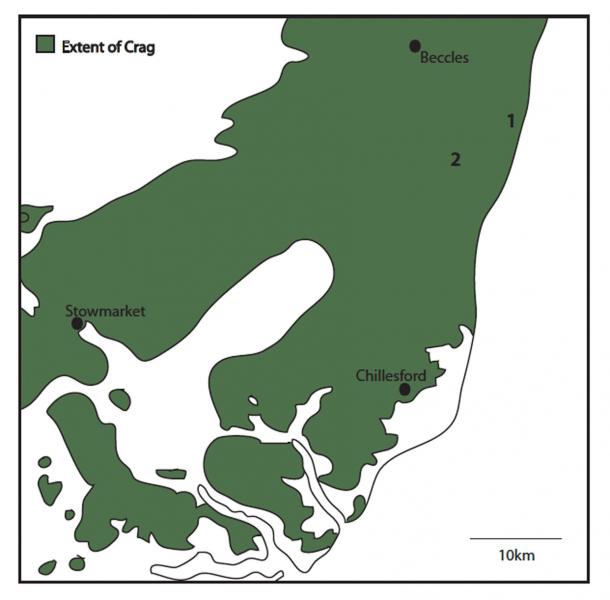The Norwich Crag outcrops mainly in Norfolk and comprises predominantly fine-grained marine sands with some gravels and clays. It has a maximum thickness of 40 metres. The formation rests unconformably on various older units, including the Coralline Crag and Red Crag formations.
In Suffolk, south of Aldeburgh, the Norwich Crag Formation is divided into the lower Chillesford Sand Member and the upper Chillesford Clay Member. Beneath the water-table the sands are dark green, but at outcrop they are oxidised and become yellow to pale brown in colour.
Sedimentary structures include horizontal bedding, ripple marks, flaser bedding, thin clay drapes, trough cross-sets up to 0.3 m thick, vertical burrows, channel scours and mudcracks. Over a large area around Southwold, the sands of the Norwich Crag are interbedded with gravels (‘Westleton Beds’) and clays, the latter usually pale to medium grey or buff, with ochreous staining.
The Chillesford Sand Member consists of well-sorted, fine to medium sands. Prestwich first recognised the Chillesford Sand in 1849 but did not use the name until 1871. Although Harmer (1900) retained this name, the term Chillesford Crag has been applied by other authors. The Scrobicularia Crag, originally defined by Wood (1866) as a thin bed characterised by the eponymous bivalve, has been applied by some (e.g. West & Norton, 1974; Dixon, 1979) as a synonym of the Chillesford Crag. Recently, however, the Scrobicularia Crag has been used to denote the beds between the Red Crag and the Chillesford Crag, particularly those thought to contain a high proportion of material reworked from the Red and Coralline Crags.
The Chillesford Clay Member consists of grey silty clays with sand laminae. Where the Chillesford Clay Member overlies the Chillesford Sand Member, the upper part of the sand sequence often becomes silty and passes gradually into the overlying clay unit.
The boundary between the Chillesford Sand Member and the Red Crag Formation is irregular; in Butley the Chillesford Sand facies is absent and the Red Crag Formation is directly overlain by the Chillesford Clay Member at around 10 m O.D., whereas near Aldeburgh the base of the Chillesford Sand Member lies at or below O.D. Usually the contact slopes gently east.
The Westleton Beds have been interpreted as beach-rip channel gravels (Mathers & Zalasiewicz 1996). They represent wave-dominated shoreline deposits contrasting with the tide-dominated deposits forming most of the Norwich Crag. The Westleton Beds are considered to be a unit of member status near the top of the Norwich Crag Formation.
Below is a list of Norwich Crag localities, shown on the map opposite. Please follow the links for more information.

Figure. Locality map of East Anglia.